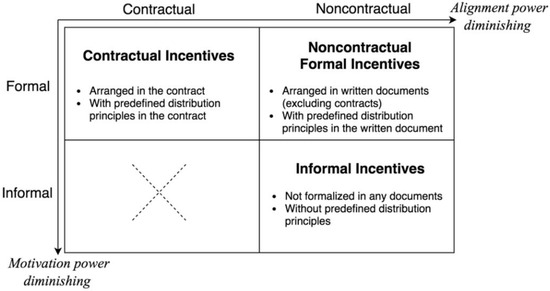You're using an outdated browser. Please upgrade to a modern browser for the best experience.
Please note this is a comparison between Version 1 by Senchang Hu and Version 2 by Camila Xu.
Commonly recognized as an effective management technique, the use of incentives plays a vital role in the successful application of these approaches.
- inter-organizational incentive
- inter-organizational relationship
- multiple incentive
1. Introduction
Faced with the challenging and uncertain business climate, construction organizations are increasingly abandoning traditional paradigms of inter-organizational relationships to embrace cooperative business strategies and to collaborate more with other organizations, sometimes even with competitors. In other words, to foster superior project outcomes, organizations are increasingly transforming traditional adversarial relationships among project parties—caused by conflicts of goals and interests—into trust-based cooperative relationships. Industry leaders adopt a variety of approaches to achieve this, such as relational contracting, alliance building, partnering, and integrated project delivery (IPD) [1][2][3][4][5][1,2,3,4,5]. Commonly recognized as an effective management technique, the use of incentives plays a vital role in the successful application of these approaches [6][7][6,7].
Inadequate inter-organizational incentives can lead to a lack of motivation for participants to improve their performance. The existing literature on the use of incentives mainly focuses on addressing their significance [7][8][9][10][7,8,9,10] and explaining how they can be designed theoretically [11][12][11,12], lacking systematic research with empirical evidence from the perspective of the inter-organizational level.
2. Classification of Interorganizational Incentives
Incentives largely fall into two categories: intra-organizational incentives and inter-organizational incentives. Intra-organizational incentives have frequently been used to design compensation schedules as a way to improve productivity, generate higher job satisfaction, achieve optimal performance, and avoid project risks. Since employee and employer interests are not always aligned, various psychologists and economists have recommended intra-organizational incentives to motivate employees to work toward company goals [13][14][15][16][13,14,15,16]. The use of inter-organizational incentives is a managerial technique adopted by one organization to motivate another organization to achieve certain business goals. For example, some companies sign revenue-sharing contracts with their suppliers to improve the efficiency of their supply chains [17]. The revenue-sharing formula in such a contract is a kind of inter-organizational incentive. Interorganizational incentives differ from intra-organizational incentives in two contexts. First, organizations have more predictable rationality than individuals, which means that inter-organizational incentive design requires more rational and economic consideration [18][19][18,19]. In other words, while individuals have limited rationality and make decisions from complicated intrinsic motivations, commercial organizations typically follow the rational principle of maximizing their economic utility [20]. The economic utility in this context can refer either to short-term business profits or the long-term benefits of such intangible goods as reputation, social responsibility, and cooperative relationships [5]. Second, organizations have less control over the behavior of other organizations than they have over their own employees since their authority formally ends at the organizational boundary [20]. Such differences between inter-organizational and intra-organizational settings necessitate different incentive approaches and, thus, different application principles. Contractual incentives are provisions arranged explicitly in a contract [21], while non-contractual incentives are not mentioned in a contract. Formal incentives are distributed according to assessable performance against principles predefined in written documents [8]. On the one hand, if the written documents include a contract, such incentives are both formal and contractual. On the other hand, if incentive distribution principles are defined not in a contract but in other written documents (e.g., memos), such formal incentives are non-contractual. Lastly, informal incentives are neither predefined nor recorded in written documents. Thus, all informal incentives are essentially non-contractual. Figure 1 outlines this classification matrix, the cells of which are explained further below.
Figure 1.
Classification of inter-organizational incentives.
